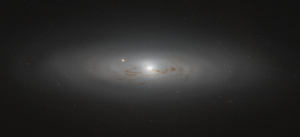NGC 4036
| Galaxie NGC 4036 | |
|---|---|
 | |
| Aufnahme des Hubble-Weltraumteleskops | |
| AladinLite | |
| Sternbild | Großer Bär |
| Position Äquinoktium: J2000.0, Epoche: J2000.0 | |
| Rektaszension | 12h 01m 26,753s [1] |
| Deklination | +61° 53′ 44,81″ [1] |
| Erscheinungsbild | |
| Morphologischer Typ | S0- / LINER[1] |
| Helligkeit (visuell) | 10,5 mag[2] |
| Helligkeit (B-Band) | 11,5 mag[2] |
| Winkelausdehnung | 4,3′ × 1,7′[2] |
| Positionswinkel | 85°[2] |
| Flächenhelligkeit | 12,7 mag/arcmin²[2] |
| Physikalische Daten | |
| Zugehörigkeit | NGC 4036-Gruppe LGG 266[1][3] |
| Rotverschiebung | 0.004620 ± 0.000017[1] |
| Radialgeschwindigkeit | (1385 ± 5) km/s[1] |
| Hubbledistanz H0 = 73 km/(s • Mpc) | (67 ± 5) · 106 Lj (20,4 ± 1,4) Mpc [1] |
| Durchmesser | 85.000 Lj[4] |
| Geschichte | |
| Entdeckung | William Herschel |
| Entdeckungsdatum | 19. März 1790 |
| Katalogbezeichnungen | |
| NGC 4036 • UGC 7005 • PGC 37930 • CGCG 292-59 • MCG 10-17-125 • IRAS 11588+6210 • 2MASX J12012689+6153445 • GC 2668 • H I 253 • h 1050 • GALEXASC J120126.74+615346.0 • NVSS J120126+615344 • WISEA J120126.77+615344.8 | |
NGC 4036 ist eine elliptische Galaxie vom Hubble-Typ E/S0 mit aktivem Galaxienkern im Sternbild Großer Bär am Nordsternhimmel. Sie ist schätzungsweise 67 Millionen Lichtjahre von der Milchstraße entfernt und hat einen Durchmesser von etwa 85.000 Lichtjahren. Die Galaxie ist das hellste Mitglied der NGC-4036-Gruppe (LGG 266).
Am 23. Juli 2007 wurde die Typ-Ia-Supernova SN 2007gi in der Nähe des zentralen Bulge dieser Galaxie entdeckt.[5]
Das Objekt wurde am 19. März 1790 von dem Astronomen William Herschel mit einem 18,7-Zoll-Teleskop entdeckt.[6]
NGC-4036-Gruppe (LGG 266)
| Galaxie | Alternativname | Entfernung/Mio. Lj |
|---|---|---|
| NGC 4036 | PGC 37930 | 67 |
| NGC 4041 | PGC 37999 | 60 |
| IC 758 | PGC 38173 | 62 |
| PGC 37951 | UGC 7009 | 54 |
| PGC 38014 | UGC 7019 | 72 |
Weblinks
Einzelnachweise
Auf dieser Seite verwendete Medien
Autor/Urheber: Judy Schmidt from Fresh Meadows, NY, USA, Lizenz: CC BY 2.0
Lenticular galaxies are the masters of subtlety. I crave subtlety. Few people pay much attention to anything unless it's loud and in your face. Do you ever get tired of that? The way we hack into the nature of our perception to get one step ahead of someone else? For what? Another "like"? Another "retweet"? It's pointless.
Despite my own words I have heavily used some processing techniques to bring this one's details into perceptible range for most humans. The dust and the faint ridges are much more gentle in reality. One lonely Milky Way star appears near the center.
Red: hst_12591_24_acs_wfc_f850lp_drz Green: Pseudo
Blue: hst_12591_24_acs_wfc_f475w_drz